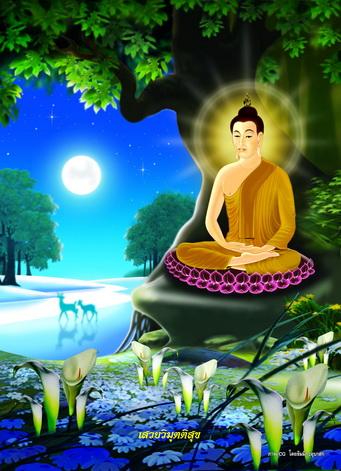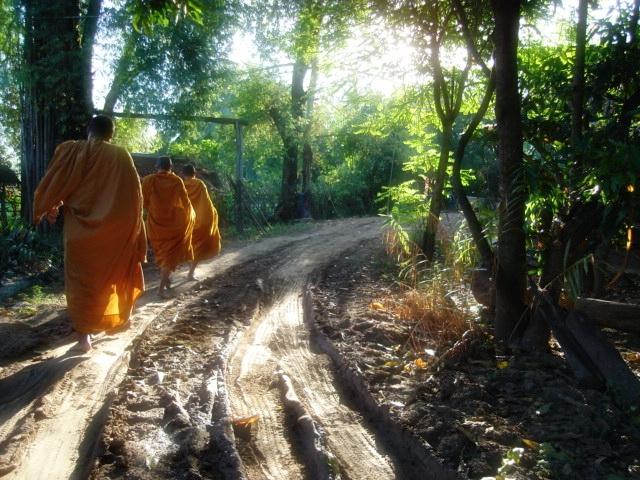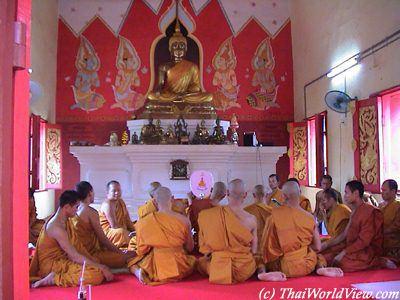“When the rainy season has come and it is raining, many living beings are originated and many seed just spring up. … Knowing this one should not wander from village to village, but remain during the rainy season in one place.” — Acaranga Sutra, Jaina Sutras I, p.136 by H. Jacobi
This passage refers to the Jain mendicants’ practice during the Buddha’s time in India, from whom the custom of rains-retreat was developed in Buddhism. During the rainy season the Jain mendicants developed the notion of non-injury (ahimsa) and paused their wandering habits. Respecting this as well, the Buddha ordered his followers to pass the rainy season in settled dwellings.
The term vassavasa means ‘residence during rains’; also known as rains-retreat. Well known in the historical story, the Buddha preached his first sermon to the five ascetics at Sarnath. In those times, his preaching tour was reduced by the three-month period spent in vassavasa. However, as this practice was not yet a formal discipline, many monks continued to wander here and there. Two considerations worth mentioning about this rainy period are 1) the difficulties of travel in historical India, and 2) the potential harm to living species.
Paths were muddy, roads were covered with water, rivers overflowed—thereby restricting the movements of travelers. Secondly, when monks traveled during the rainy season, they potentially injured all forms of life including plants and creatures that surfaced with the rains. People criticized the monks for this and thus the Buddha laid down the precept and enjoined the monks to enter a rains-retreat in a fixed location. The specific dates of the rains-retreat period vary somewhat: referring to the earlier (purimika in Pali) and later (pacchimika) timing. The earlier period of rains-retreat spans from June-July (asalha; full moon) to September-October (full moon) of the Buddhist lunar calendar.
The later period begins one month after the earlier date: July-August (savaaa full moon) to October-November full moon of Buddhist month. Each period is 3 out of 4 months in duration of the rainy season (according to Buddhist counting). For all monks and nuns it is compulsory to observe rains-retreat.
However, according to Buddhist discipline they are allowed to spend for seven days out of their residence for a few particular reasons: for example, to attend to the Buddhist Saṅgha, to give a Dhamma talk, or to visit relatives who have fallen ill. After the task or visit is completed, they should return within seven days to their residence. It is also important to mention that if the location for retreat is vulnerable to danger from thieves or wild animals, then a monastic member is allowed to dispute the retreat without any offence of transgressing a rule of discipline.
During the rains-retreat, the monastic Saṅgha was advised to settle where alms-food and other requisites would be available without extensive travel. The retreat settlement is clearly defined in the Mahavagga (The Book of the Discipline, Vol. iv, 51p. I.B. Horner) stating: neither too far from a village nor too near, suitable for coming and going, accessible for people whenever they want, not crowded by day, having little noise at night, little sound, without folk’s breath, haunts of privacy, suitable for seclusion.
For rains-retreat, two types of settlements were generally indicated in Buddhist monastic code: avasas and aramas in Pali. The avasas were constructed by monks themselves as a monastic dwelling place made with natural boundaries such as a mountain, rock, tree and so on, and that no one infringed upon another. These were temporary places set-up and at the end of the rains-retreat removed by monks.
A specific chapter in the Mahavagga, Chapter III (I.B. Horner) details the construction, maintenance, and regulations for these avasas. In contrast to the rather temporary avasas, the dwelling place of aramas, was more permanent in nature, where a number of monks would dwell together. The word Sangharama indicates a dwelling for the Buddhist Sangha and it is a monks’ private property donated by lay devotees. Several donations of these aramas are mentioned in the Tipitaka; one notable example being King Bimbisara’s donation of Veluvana in Rajagriha. Symbolically, this gesture represented the first offering of its kind to the Buddhist Saṅgha. Later developments of the aramas became known as monasteries, or Buddhist temples, where large numbers of monks resided.
The significance and impact of the rains-retreat evolved from the early temporary locations called avasas. The aramas, or more permanent dwellings, influenced the Buddhist Saṅgha in such a way that longer-term communities began to form and a collective life emerged with numbers of monks living together in one place permanently. This idea was seeded originally with the institutionalization of rains-retreat. Additional structures like meeting halls, storerooms, bathrooms, and kitchens became evident to the Buddhist Saṅgha to meet their community needs. Rules and regulations for the management and administration of these communities developed as well. What began simply as a 3-month pause in the practice routines of itinerant monks became an institutional development that would greatly influence lay and monastic cooperation. Additionally, the formalized rains-retreat would impact the monastic rules for practice and development of spiritual life.
Often in present day, the rains-retreat practice is not limited within the Buddhist Saṅgha, but lay followers can be found observing the period in Thailand, Myanmar, Sri Lanka and Bangladesh. During rains-retreat, lay followers take certain vows and observe the precepts rigorously, engaging in activities such as: providing alms food to monastic Sangha, giving up smoking and intoxicants, observing the eight precepts, practicing meditation, chanting Buddhist Suttas and listening to Dhamma talks. At the end of the rains-retreat the Buddhist Sangha performs a special ceremony called the pavaraṇa, where each one invites his fellows to point out any mistakes committed during the retreat period. It is well documented in the texts that during the rains-retreat, many monks and nuns achieved spiritual goals. The rains-retreat affirms that both monastic and lay community have developed over time in mutual co-operation and observance of the Buddha’s teachings. Undoubtedly, with the institutionalization of the rains-retreat, the Buddhist Sangha has performed an important role in the development of Buddhism.
Part 2 in this series: The amplification of Buddhist monastic rules during the rains-retreat (vassavasa)
Part 3 in this series: The Significance of the Kathina Robe Offering Ceremony














